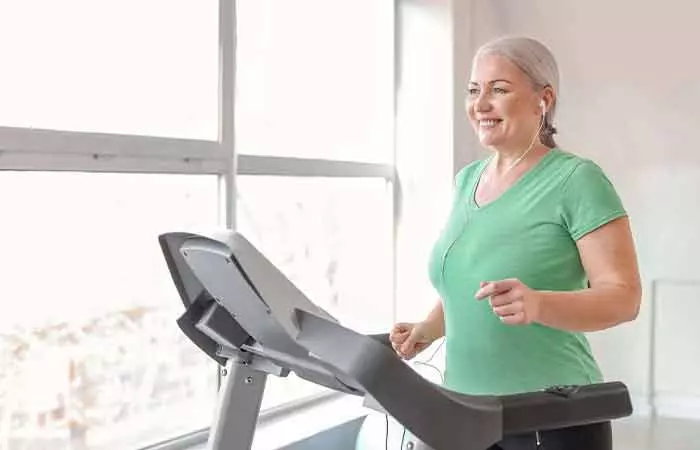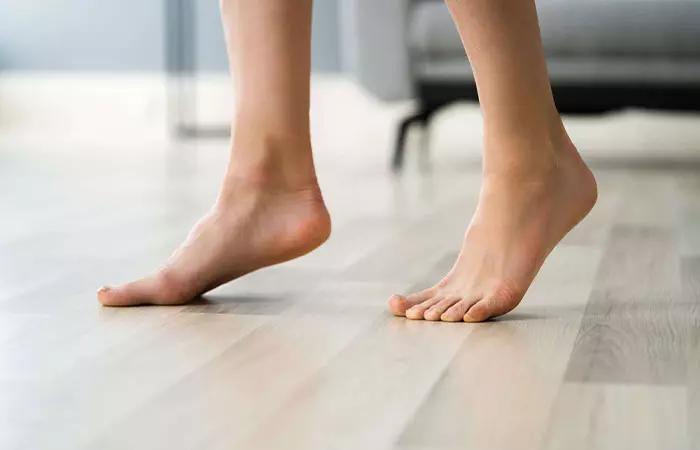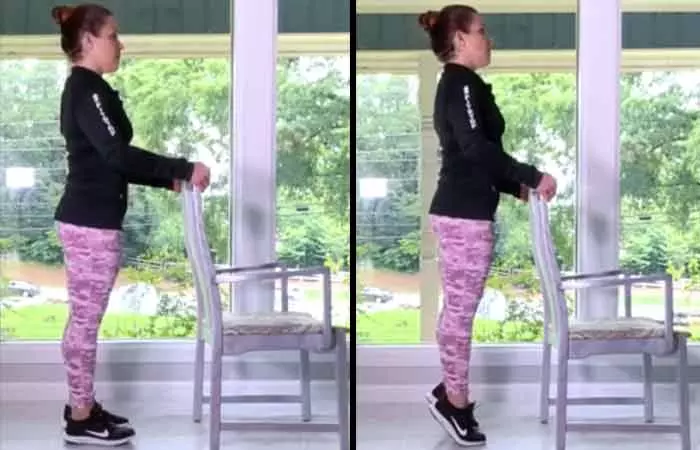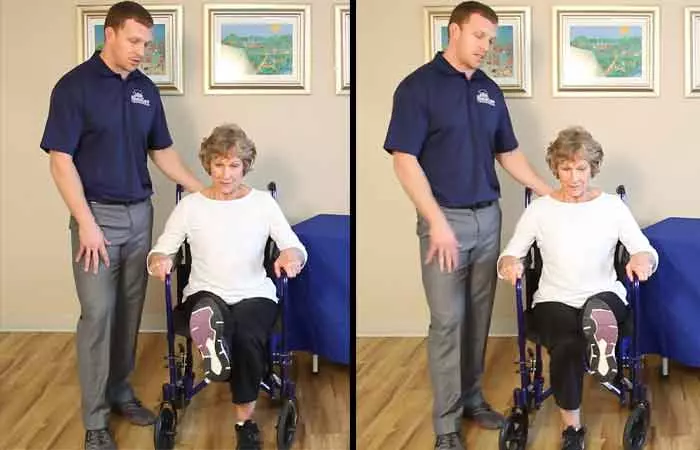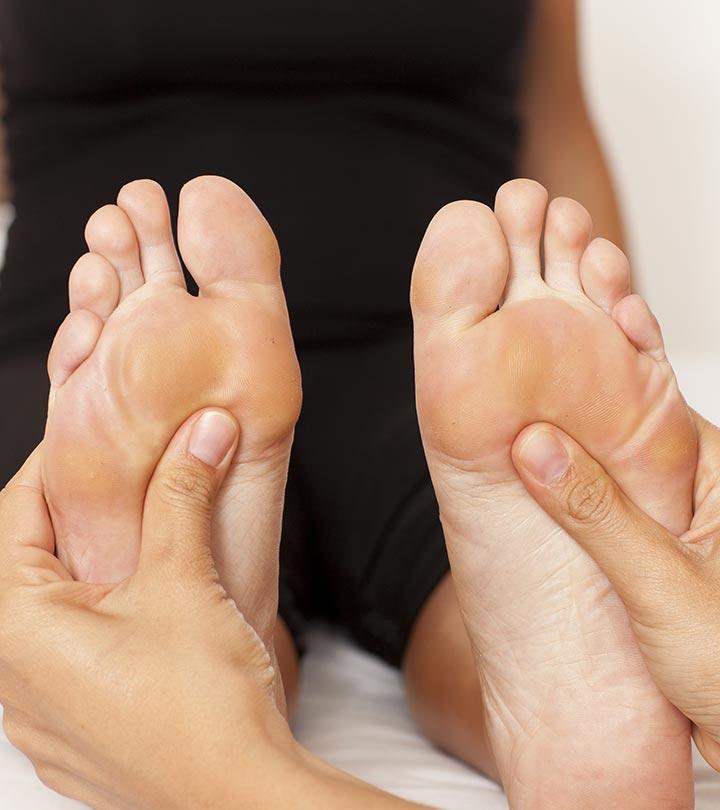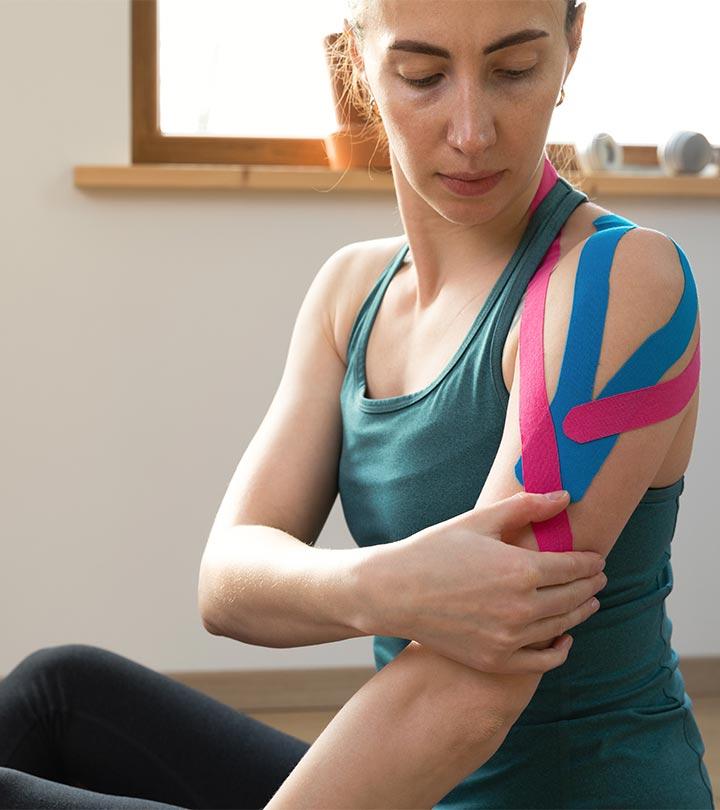7 Best Exercises For Peripheral Artery Disease & What To Avoid
Learn which exercises to do and avoid to manage Peripheral Artery Disease.

Image: Shutterstock
Exercises for Peripheral Artery Disease (PAD) reduce the debilitating effects of this disease. PAD affects leg mobility and causes pain (1). About 220 million people worldwide are affected by PAD (2). The only treatment for PAD is early diagnosis and professionally supervised physical therapy. Exercise may turn out to be an effective form of rehabilitation and may help reduce the risk of disability and any deterioration of cardiovascular health (3). Consult your doctor and start doing exercises for PAD. This post also tells you which exercises to avoid. Read on!
 Workout Blueprint: Exercises For Peripheral Artery Disease
Workout Blueprint: Exercises For Peripheral Artery Disease- Frequency: 3-4 times per week
- Benefits: Improve cardiorespiratory fitness, mobility, and balance.
- Equipment Needed: Chair, treadmill, resistance band.
- Space Required: Small area
- Assistance Required: Yes
- Who Should Avoid: Anyone who has undergone surgery recently.
In This Article
What Is Peripheral Artery Disease?
Peripheral artery disease (PAD) is caused by plaque buildupi The buildup of plaque (cholesterol deposits, cellular waste, calcium) in the arteries, causing them to become thick. in the arteries, restricting blood flow to the lower extremities. Reduced blood flow causes leg pain or intermittent claudication (limping) and walking difficulties and hampers day-to-day tasks (1). PAD can gradually decrease leg mobility, increase the risk of heart disease, and may need surgery in extreme cases. That is why you should be careful and look out for signs and symptoms for proper diagnosis. Scroll down to read more about PAD.
Symptoms, Causes, And Diagnosis
Symptoms
- Leg pain, cramps, and aches
- Muscle weakness
- Skin cold to touch
- Smooth and shiny skin
- Hair loss
Note: Asymptomatic PAD does not cause leg pain.
The above symptoms may or may not indicate peripheral artery disease. Conditions (like arthritis) or vein-related issues may also cause leg pain. However, the following risk factors increase the chances of developing PAD (1):
Risk Factors
- Age above 60
- High cholesterol
- High blood pressure
- Obesity
- Diabetes
- Smoking
- Atherosclerosis (arterial plaques)
If you have more than one of the risk factors listed above, you must get a formal diagnosis. Here’s how your doctor will do the diagnostic test for PAD.
Diagnosis
The doctor will perform an ankle-brachial index (ABI) test. It is a non-invasive test to compare the blood pressure in your ankles and arms at rest and after exercise. The doctor may also perform other tests like ultrasound, magnetic resonance angiographyi A technique used to develop images of arteries to evaluate them for abnormalities like occlusion, stenosis, or aneurysms. , and computed tomographic angiographyi A medical test that uses a CT scan to generate images of arteries for evaluation purposes. to confirm PAD (3).
 Quick Tip
Quick TipDepending on your disease progression, the doctor will recommend supervised physical exercise and medications to manage the symptoms of peripheral artery disease. Scroll down to check out the best exercises for PAD.
7 Best Exercises For PAD
PAD commonly affects the legs. Therefore, it becomes difficult to walk long distances. However, several uncontrolled trials indicated the clinical efficacy of exercise therapy in increasing pain-free walking distance by 180% (3). It also improves cardiorespiratory fitnessi The capacity of the respiratory and circulatory systems to supply adequate oxygen to skeletal muscles during physical activity. and the quality of life of people with peripheral artery disease (4).
Exercising for 30 minutes, 3-4 times a week, can improve PAD symptoms to a great extent. Below, you will find a list of safe exercises you can do under a supervisor or in a group physical therapy class for PAD (5).
Note: Follow the claudication pain scale while exercising. Stop and rest when your pain is at level 3. Resume exercising once the pain subsides.
| Claudication Pain Scale | |||||
| 0 | No Discomfort | ||||
| 1 | Minimum Discomfort | ||||
| 2 | Moderate Pain | ||||
| 3 | Intense Pain | ||||
| 4 | Unbearable Pain (Stop exercising) | ||||
1. Intermittent Walking
You can do this outdoors or on a treadmill. Start with short distances. If possible, choose a path that has low-rise inclines intermittently. When walking on the treadmill, take your hand off the sidebars. “Walking regularly, if you can do so pain-free and with express permission and recommendation from your healthcare provider, is one of the best actions you can take for your health, period,” says personal trainer David Rosales, a personal trainer.
2. Toe Walking
Walk on the balls and toes of your feet on a flat surface. If you are at home, do this exercise near a wall for support. If in group therapy, place chairs in a circle and walk around. This exercise involves the muscles in the calves and feet and increases blood flow.
3. Assisted Standing Calf Raises
Stand behind a chair and hold the backrest or a walking bar for support. Raise your heels and lower them. Do this until you experience discomfort. Rest for a while and do a few more reps. Your calf muscles can also get tight, especially if you are used to wearing heels. So, you should stretch your calves with some dorsiflexion exercisesi Also known as ankle flexions, these are actions of stretching the foot towards the shin in an upward movement. .
4. Step-Ups
Step-ups are great for improving mobility, balance, and lower body coordination. To do this exercise, use a staircase at your home or the steps provided at the group therapy. Move up a step with your right leg and come down with your right leg. Do this 10 times before repeating the same with the other leg.
5. Chair Sit-Stand-Heel-Raises Exercise
This exercise improves knee mobility and balance, strengthens the calf muscles, and improves coordination. Do it under the supervision of an expert. Start by sitting on a chair. Stand up, do a calf raise, lower your heels, and sit down on the chair. Repeat the movements.
6. Reverse Lunges
Reverse lunges target the glutes, thighs, and calves. Place your hand on the wall for support, stand straight, with your legs shoulder-width apart. Take a step back with your right leg. Bend both knees and lower your body until your thighs and calves are perpendicular to each other. Pause for a moment and get up. Repeat with your left leg. Stop and rest if you experience discomfort.
7. Chair Leg Raises
Chair leg raises are great for improving blood flow from the hips to the toes. Sit on a chair with feet flat on the floor. Lift your right leg off the floor and extend it. Hold it for 5 seconds and gently lower it. Repeat with the left leg. Stop and rest if you experience discomfort.
 Quick Tip
Quick TipWhile regular physical activity is beneficial for people with PAD, choose activities that do not overwork your heart. Here is a list of exercises you should avoid.
Exercises To Avoid
- Running
- Rope jumping
- Swimming
- Cycling
- High-intensity exercises
- Weightlifting
Note: You may use therapy bands to include resistance exercise in your routine if your physical therapist recommends it. Otherwise, stick to the 7 exercises mentioned in the previous section.
The exercises above may not necessarily be problematic, depending on the state of your condition. You should work closely with your health care providers to determine your specific exercise routine.
Infographic: 5 Effective Exercises For Peripheral Artery Disease
Peripheral Artery Disease (PAD) causes pain and makes movement and everyday chores difficult. People above 60 years or who have high cholesterol, high blood pressure, obesity, or diabetes are prone to this disease. However, exercise can help improve the symptoms and may restrict the progression of the disease. We have compiled a list of the 5 most effective and easy exercises for people struggling with PAD. Scroll down and check out the infographic for more details.

Illustration: StyleCraze Design Team
Exercises for peripheral artery disease are the best way to treat this condition, whose risk factors include old age, high cholesterol, hypertensioni A medical condition where the blood pressure in the arteries is higher than normal. , smoking, obesity, and diabetes. However, you may need surgery in extreme cases. The exercises discussed in this article improve blood circulation from the hips to the toes and strengthen the muscles in the lower body. However, exercises like running, rope jumping, and swimming are a big ‘no’ for individuals with this condition. If you notice the symptoms of this disease, consult a doctor immediately and get started with physical therapy. Also, try to adopt healthy habits and focus on strength training and some lifestyle changes for overall betterment.
Frequently Asked Questions
Are compression socks good for peripheral artery disease?
No. Although compression socks may provide some relief, people with severe peripheral artery disease (PAD) should avoid them as they may restrict blood flow into the legs.
Is heat good for peripheral artery disease?
Yes, heat may be suitable for managing peripheral artery disease. A study found that heat therapy improved walking distance in people with PAD and their resting blood pressure levels (6).
How can I unblock my peripheral arteries without surgery?
You can start by changing your lifestyle by quitting smoking, maintaining a fiber-rich diet that is low in sodium, cholesterol, and fat, exercising, regulating blood pressure and cholesterol, reducing stress, and practicing yoga and a foot care regime.
How to treat peripheral artery disease in Ayurveda?
Follow a Kapha-pacifying diet that includes astringent, bitter and pungent foods, eat pulses and dried beans, avoid sweet, salty, and sour foods, eat warm and cooked food, and perform yoga asanas daily.
What are the warning signs to watch for during exercise if I have PAD?
If you experience intense painful cramping, stop exercising and give yourself a break. You can resume with light exercises once the pain subsides.
Is it safe to exercise with PAD if I have other medical conditions too?
Light exercises recommended for PAD are generally safe even if you have other medical conditions. However, consult your doctor before starting them to ensure there are no risks.
Key Takeaways
- Peripheral artery disease (PAD) causes leg pain due to a limited blood flow to the lower extremities.
- Several studies have demonstrated the benefits of exercise therapy in managing PAD symptoms.
- Exercises like intermittent walking, toe walking, and step-ups help improve the symptoms.
Learn how walking can help manage peripheral artery disease. Watch the video below to discover the benefits of walking and how it can improve your health.
References
Articles on StyleCraze are backed by verified information from peer-reviewed and academic research papers, reputed organizations, research institutions, and medical associations to ensure accuracy and relevance. Read our editorial policy to learn more.
- Peripheral Arterial Disease
https://www.ncbi.nlm.nih.gov/books/NBK430745/ - Evidence-Based Medical Management of Peripheral Artery Disease
https://www.ahajournals.org/doi/10.1161/ATVBAHA.119.312142 - Exercise Rehabilitation in Peripheral Artery Disease: Functional Impact and Mechanisms of Benefits
https://www.ncbi.nlm.nih.gov/labs/pmc/articles/PMC3061490/ - Exercise training for management of peripheral arterial disease: a systematic review and meta-analysis
https://pubmed.ncbi.nlm.nih.gov/25230780/ - Prevention and Treatment of PAD
https://www.heart.org/en/health-topics/peripheral-artery-disease/prevention-and-treatment-of-pad - Heat therapy vs. supervised exercise therapy for peripheral arterial disease: a 12-wk randomized, controlled trial
https://pubmed.ncbi.nlm.nih.gov/31002283/
Read full bio of David Rosales
Read full bio of Ravi Teja Tadimalla
Read full bio of Payal Karnik





